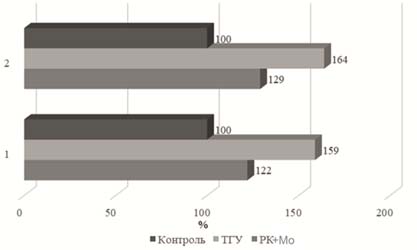Изменение урожайности и химического состава люцерны посевной под воздействием удобрений
DOI:
https://doi.org/10.31251/pos.v8i2.269Ключевые слова:
люцерна посевная; урожай; удобрения; микроэлементы; Амурская область.Аннотация
Цель исследования. Оценить изменение урожайности люцерны посевной и содержания в ней биофильных и токсичных элементов под воздействием различных удобрений в условиях южной зоны Амурской области.
Место и время проведения. Экспериментальную часть исследования провели в 2005–2006 гг. на территории учебно-опытного хозяйства Дальневосточного государственного аграрного университета (с. Грибское, Амурская область).
Методы. Микрополевые опыты проведены в трех повторностях. Физико-химические свойства почв определяли по общепринятым методикам, элементный химический состав почвенных и растительных образцов исследовали атомно-абсорбционным методом, для обработки полученных данных использовали методы вариационной статистики.
Основные результаты. Урожайность люцерны посевной в вариантах опыта возрастала в ряду: контроль < минеральные удобрения < торфогуминовые удобрения, оставаясь на примерно одинаковом уровне в течение эксперимента. Из изучаемых элементов больше всего люцерна накапливала цинк и бор, причем более активно при внесении торфогуминовых удобрений. Содержание цинка в люцерне посевной во всех случаях превышало нормируемые значения. Внесение минеральных удобрений увеличило содержание молибдена в растениях до значений выше допустимого уровня. Концентрация кадмия и селена в растениях была минимальна, и между вариантами опыта статистически значимые отличия не выявлены, а максимально допустимый уровень кадмия не превышен.
Заключение. Установлено, что торфогуминовые удобрения способствуют большему увеличению зеленой массы люцерны по сравнению с минеральными. Люцерна посевная активно накапливает цинк и бор, содержание потенциально токсичных элементов – кадмия и свинца – не превышает максимально допустимых величин. Выявление продукционных особенностей и химического состава люцерны посевной, особенно в плане содержания в ней биофильных и токсичных элементов под воздействием различных удобрений, в условиях Амурской области имеет важное значение для разработки технологий, направленных на повышение количества и улучшения качества продукции кормопроизводства.
Скачивания

Загрузки
Опубликован
Как цитировать
Выпуск
Раздел
Лицензия
Copyright (c) 2025 Почвы и окружающая среда

Это произведение доступно по лицензии Creative Commons «Attribution» («Атрибуция») 4.0 Всемирная.






